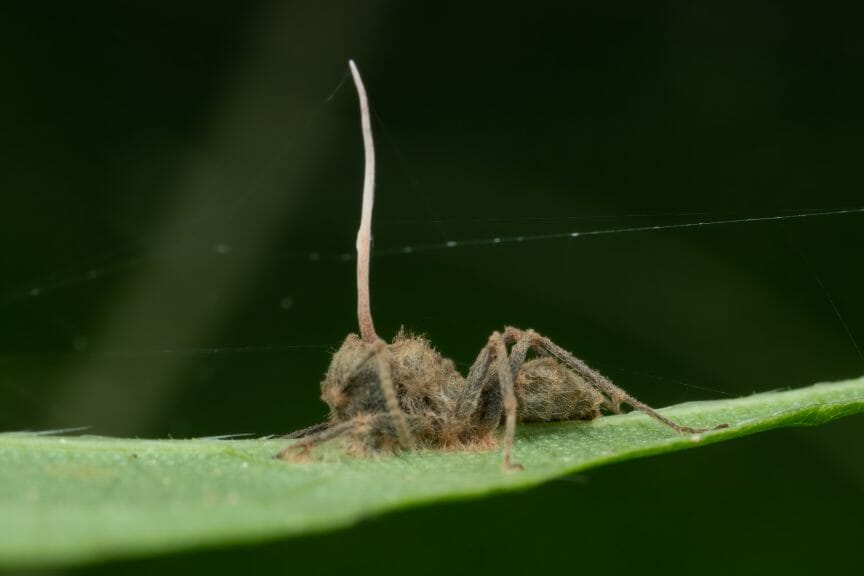The new series The Last of Us has taken the television world by storm, but exactly how much of the show is possible?
Zombie books, movies, and shows have been around for decades by now. From The Walking Dead, World War Z, and even Pride and Prejudice and Zombies, it seems like every iteration of zombie content has been done. The most recent hit show, The Last of Us, also features zombies. But how could it possibly be anything different from the rest?
Just another zombie show?
The Last of Us, which premiered on HBO Max on January 15, imagines an alternate reality in which a fungus transforms humans into violent predators driven to attack and kill everything in their sight. In twenty years, 60% of the human population is killed or zombified by the parasitic Cordyceps fungus.
Sounds like just another zombie-themed show, right? Where The Last of Us differs from the rest, though, is that the infectious fungus taking over the fictional world exists in real life.

Credit: Flickr/naughty_dog
Cordyceps is a real fungus, and it does indeed transform normal, functional organisms into zombie-like beings.
What exactly is Cordyceps?
The fungal parasite Cordyceps, similar to the one in The Last of Us, affects a specific ant species. Its scientific name is Ophiocordyceps unilateralis, but it was originally known as Cordiceps unilateralis, hence “Cordyceps.” Scientists haven’t yet determined precisely how, but Cordyceps infects ants and takes over their nervous system. From there, the parasitic fungus can control the ant and its behavior.
Cordyceps typically drives ants to climb nearby plants and attach themselves to the underside of leaves. The fungus then begins the slow process of replacing the ant’s flesh with spores. After a few days, the only remaining part of the original ant is its exoskeleton.
The spore then bursts out of the ant’s husk, showering spores onto underlying surfaces from its prime position upside down on a leaf.

Credit: Shutterstock/Chui Wui Jing
Cordyceps doesn’t only infect ants, though. Another species of Cordyceps, Cordyceps ignota infects tarantulas. Unlike Ophiocordyceps unilateralis, Cordyceps ignota doesn’t take over the tarantula’s actions. The fungal parasite does though repeat a similar process of infecting the spider from the inside out. Much like the ant, the fungus continues until only the spider’s skin remains. Similar to the ant, the tarantula eventually explodes with spores, spreading fungal matter throughout the air to infect more and more spiders.
Can Cordyceps infect humans too?
In the video game and television show The Last of Us, Cordyceps infects humans as well as insects. In the fictional world, the fungus evolved to jump species, eventually adapting the capacity to infect humans. Much like the ants, the fungus first controls the behavior of infected humans, driving them to extreme states of aggression.
Before long, the infected humans, as well as the infected ants, are completely taken over by the fungal growth. Spore growth erupts from their face and body, taking over their powers of sight, and entirely rupturing their recognizable humanity. The Last of Us called these un-dead beings “clickers.”
In their final stage of “life,” Cordyceps drives The Last of Us humans to a private space. This is where the person dies, and where spores emerge from the hosts’ body. Now in the atmosphere, Cordyceps is likely to spread and infect even more humans.

Credit: YouTube/HBO Max
But could Cordyceps ever infect humans like it does in The Last of Us?
Scientists say no.
Bryn Dentinger, a professor of biology at the University of Utah with a special focus in mycology, spoke to NPR about how accurate The Last of Us really is––and if humans should be preparing for a potential outbreak of Cordyceps.
Dentinger, a personal fan of the show, explained that the Cordyceps fungus cannot––under any current terms or conditions––infect humans.
“Our body temperatures are high enough that most organisms, their proteins, would denature at that temperature, so they can’t survive in our bodies,” Dentinger told NPR. Basically, humans are too hot for Cordyceps to survive in our bodies, take over our brains, and zombify the population.
However, as the global temperature continues to rise, certain fungi are newly developing the ability to survive in and infect human bodies.
It is possible, Dentinger admits, that, one day, certain fungi with mind- or body-control capacities could evolve and withstand the high basal body temperature of humans. After all, humans make use of many of several mushrooms that can survive our high temperatures on a regular basis. Yeast is found in both bread and the human gut. Psilocybin, or “magic mushrooms,” are well-known for their psychoactive effects on the human brain.

Credit: YouTube/HBO Max
“We’re seeing more fungal infections in humans, but again, to date, none of them are Cordyceps,” Dentinger commented. “However, maybe that will happen in the future. But, at the moment, that is not a possibility.” Despite the long-term possibility of a mind-controlling fungus like Cordyceps gaining prominence, Dentinger reassured readers that the leap from ants to humans is a very difficult one.
The traits that allow Cordyceps to infect ants or tarantulas are specific to the host species. They are not transferable traits. It would take a long time and very specific circumstances for the fungal parasite to develop those traits. So, breathe easy, and know your air is clean––at least of human-mind-controlling, parasitic spores.
Interested in reading more about the latest in television? Click here to read about That ’90s Show and every way it honors its much-beloved predecessor That ’70s Show.














